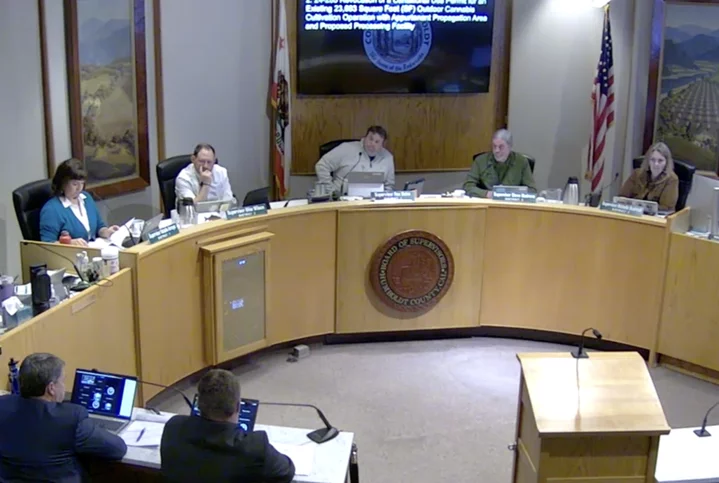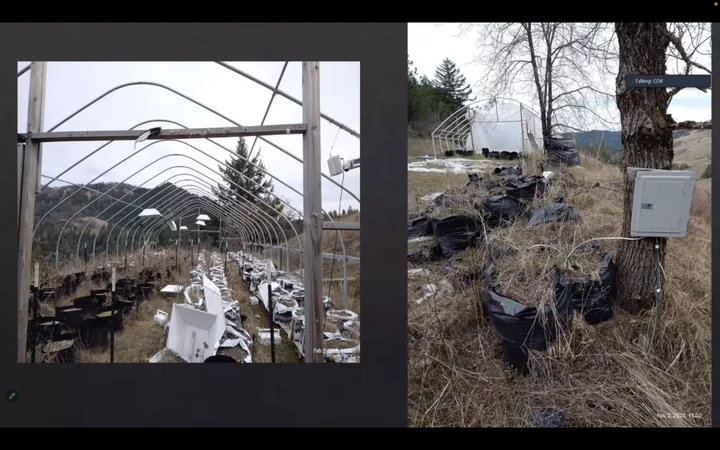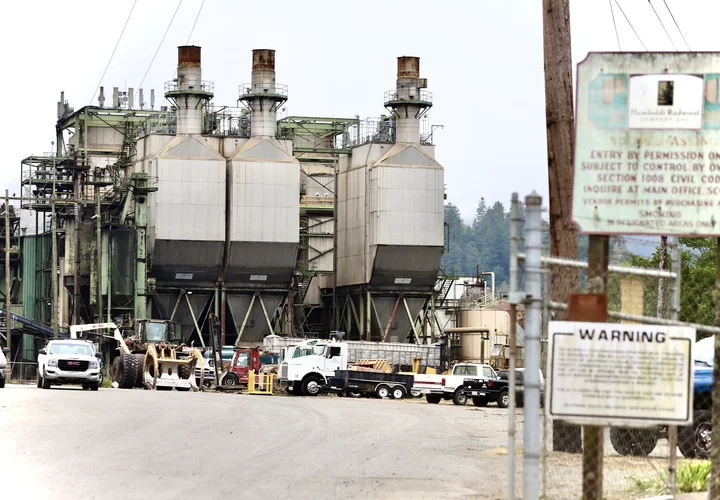TODAY in SUPES: As Weed Farms Fail, They’re Leaving Debt and Degradation in Their Wake
Ryan Burns / Tuesday, March 12, 2024 @ 4:04 p.m. / Local Government
Your Humboldt County Board of Supervisors (from left): Natalie Arroyo, Mike Wilson, Rex Bohn, Steve Madrone and Michelle Bushnell. | Screenshot.
###
Here we are again, Humboldt.
Like the fishing and timber industries that preceded it, the local cannabis-based economy has, by all accounts, fallen prey to the predictable boom-and-bust cycle of resource extraction. Factor in overproduction in the statewide marketplace and a still-thriving black market and voilà: the storied local weed industry finds itself squarely in “bust” mode.
Witness today’s Board of Supervisors meeting, during which the board unanimously revoked a pair of cultivation permits issued to growers who appear to have abandoned their farms, leaving behind illegal water diversions, un-permitted infrastructure, environmental degradation and thousands of dollars in unpaid taxes and fees.
Even with the specter of Measure A apparently in the rear-view, Third District Supervisor Mike Wilson said he expects this type of thing to continue.
“I think what we’re gonna really be dealing with here in the future is the environmental impacts of contraction, not expansion,” he said with relationship to the industry.
Both of the permits revoked at today’s meeting were for grows of a little over half an acre. For the first one, Planner Joshua Dorris presented a history of the site, located north of Honeydew off the Mattole Road. Dorris said the applicant started growing without a state license and without completing the conditions of approval for a permit from the county.
In September, the California Department of Fish and Wildlife served a search warrant to the property, and staff located 1,069 growing cannabis plants in two greenhouses, plus 28 pounds of processed cannabis and multiple violations of agency code. Notices were sent and posted to the property without reply.
However, the applicant, Evan Kouchalakos, called in today to argue that there had been a misunderstanding. He said it was the previous property owner who illegally diverted water, and that a consultant he’d hired was supposed to have paid the state licensing fee but never did.
“Our intention was never to not comply to everything,” Kouchalakos said. He added that the board “has every right to take action,” but he asked them to suspend his license rather than revoke it so he could resolve the various issues.
“I never intended to break the law,” he said.
The board couldn’t be swayed, though. First District Supervisor and Board Chair Rex Bohn said there had been plenty of correspondence giving him a chance to address these outstanding matters.
Fourth District Supervisor Natalie Arroyo said she finds the illegal water diversion “deeply problematic,” and she addressed the economic implications of such rule-flouting grow ops.
“I couldn’t in good conscience support the continuation of this permit given that, essentially, without being state-licensed, this product is what’s undercutting the market for those who have complied with the rules,” she said.
Third District Supervisor Mike Wilson agreed, though he pointed out that revoking permits will inevitably lead to unpaid bills and unaddressed environmental issues.
“If the [cultivation] sites no longer have the ability to generate revenue, there isn’t anything to pay for that cleanup,” he said, “and it devalues those properties to such an extent that we’re gonna see more and more abandonments.”
Suggesting that today’s hearings may be a “harbinger” of things to come, Wilson said that anyone who drives around the county can see evidence of the severe contraction in the industry, from abandoned hoop houses to unmaintained roads and vacant farm sites.
Screenshot from a staff report showing an abandoned hoop house with deteriorating grow bags and illegal wiring.
###
The second permit revocation of the day was an example of just that: an abandoned grow operation along Hwy. 36 near Bridgeville. Associate Planner Michael Kein showed the board a series of photos taken during inspections in 2022 and 2023, which found discarded lighting ballasts, plastic sheeting, construction materials, used soil, trellis materials and household items, plus several non-operational vehicles on the property.
The associated applicant failed to meet the conditions of approval for their permit, and Kein said they owe more than $4,000 to the Planning and Building Department, plus about $17,000 in unpaid Measure S cultivation taxes.
Second District Supervisor Michelle Bushnell asked Planning and Building Director John Ford whether the applicant had made any arrangements to pay those bills. Bohn responded by asking whether the applicant was online or in the audience. When there was no reply he said, “There’s your answer.”
At one point, Fifth District Supervisor Steve Madrone suggested that out-of-business weed growers now have the opportunity to generate income “through what has always been the tradition, and that is forest management.” He noted that the value of Douglas fir, redwood and other species is “quite high” right now.
Bohn was skeptical, saying the majority of these parcels have no marketable timber on them.
Addressing the matter of unpaid fees and taxes, Madrone asked whether a lien could be placed on properties like this one. Ford said the county can’t issue liens for unpaid fees. “So that [bill] goes to collections and probably would never be paid,” he said.
But Ford said the county has worked with a firm that facilitates receiverships of such properties, explaining that a receiver will take control of a property, clean it up and sell it, receiving the benefits of that labor while abating environmental issues.
Arroyo later said she’s interested in exploring that process further. Ford indicated that staff will embark on that mission and bring something back to the board at a later date.
Wilson, meanwhile, floated the notion of a tax — or perhaps a diversion of taxes collected in property resales — with revenues funding cleanups.
Ultimately, as noted above, the board voted unanimously to revoke both permits.
###
What else happened:
- The board was scheduled to consider establishing a Private Land Intentional Community Shelter Program, which would address homelessness by allowing private property owners to rent out space to transient community members seeking temporary living arrangements. A couple of residents from the oft-discussed “Yee Haw” communal living property near Trinidad called in to advocate for such a program. However, the agenda item was pulled, apparently to be discussed at a future meeting.
- After hearing testimony from a number of local veterans, the board agreed to increase the stipends it provides to three of the five county-owned Veterans Memorial Halls in Humboldt, those located in Arcata, Fortuna and Ferndale. The stipends are intended to offset utility payments, but veterans groups say those payments — the product of a decades-old agreement — don’t come close to covering their actual costs. Wilson voiced concern about inefficient energy systems in these old buildings. Bohn lamented the time it takes to get heating systems fixed. Arroyo said she’d work with the Redwood Community Energy Authority staff to explore possible solutions.
- The board unanimously approved the county latest strategic plan, which covers the timespan of 2024 through 2028. The board had been working on the plan for the past year, with Arroyo and Wilson comprising a working group that met with department heads. The plan is considered a guiding document and a tool that “sets the tone and direction” for the entire organization while ensuring that the county works “toward addressing the community’s needs with the resources available,” according to a staff report. You can download a pdf of the colorful 22-page document by clicking here.
BOOKED
Today: 2 felonies, 11 misdemeanors, 0 infractions
JUDGED
Humboldt County Superior Court Calendar: Today
CHP REPORTS
10556-10613 Us199 (HM office): Trfc Collision-Unkn Inj
ELSEWHERE
Governor’s Office: Governor Newsom issues legislative update 10.13.25
Governor’s Office: Governor Newsom pre-deploys additional storm safety resources to Southern California ahead of extreme weather
Governor’s Office: Governor Newsom issues legislative update 10.13.25
RHBB: Controlled Burn Planned Near Laytonville as Part of Forest Health Initiative
Eureka Teen Arrested After Advertising Drugs for Sale on Social Media, 3D-Printing Firearms, Says Drug Task Force
LoCO Staff / Tuesday, March 12, 2024 @ 3:24 p.m. / Crime
Humboldt County Drug Task Force release:
In February of 2024, Humboldt County Drug Task Force (HCDTF) Agents began investigating Austin BEATTIE (19 years old from Eureka). BEATTIE had been identified by HCDTF Agents as advertising narcotics and firearms for sale on various social media sites.
An HCDTF Agent arranged a meeting with BEATTIE wherein BEATTIE sold an undercover HCDTF Agent 4 grams of MDMA and 60 grams of psilocybin mushrooms.
On March 12, 2024, an undercover Agent met with BEATTIE once again to purchase a half ounce of cocaine. BEATTIE sold the cocaine to the undercover Agent and was detained by HCDTF Agents shortly after. Agents located a 9mm semi-automatic firearm on BEATTIE’s person. There was also a juvenile in the vehicle with BEATTIE.
HCDTF Agents then served a search warrant at BEATTIE’s residence in Samoa where they located a 3D printer that was being used to print firearms. A Polymer-80 lower was being printed as Agents served the search warrant. Agents also located digital scales, indicia, packaging materials and 2 ounces of psilocybin mushrooms.
Austin BEATTIE was transported to the Humboldt County Correctional Facility where he was booked on the following charges:
- HS11370.1(A)- Possession of a Controlled Substance while Armed
- HS11351- Possession of a Controlled Substance for Sales
- HS11352(A)- Transportation of a Controlled Substance for Sales
- PC273a(A)- Child Endangerment
- PC29010(B)- Using a 3D Printer to Manufacture Firearms
Anyone with information related to this investigation or other narcotics related crimes is encouraged to call the Humboldt County Drug Task Force at 707-267-9976.
Activists to Turn Up Heat on Scotia Biomass Power Plant at Energy Authority’s Community Advisory Committee Meeting Tonight
Hank Sims / Tuesday, March 12, 2024 @ 1:34 p.m. / Local Government
Photos: Andrew Goff.
In recent months, Dr. Wendy Ring — a local physician and activist — has been lobbying local governments to take a look at the Scotia Biomass Plant, a significant portion of the local electrical supply portfolio.
With a website and in presentations to local boards and councils, Ring’s “Humboldt Coalition for Clean Energy” has called upon the Redwood Coast Energy Authority — an intergovernmental agency that manages Humboldt County’s energy needs — to divest from its interests in biomass power, and particularly from the Scotia plant, which is run by a division of the Humboldt Redwood Company.
The Scotia plant — which generates electricity by burning wood waste — puts hundreds of thousands of tons of carbon dioxide into the air every year, the coalition argues. And yet our public energy authority, which has a long-term contract to buy power from Scotia, is allowed to claim this as a “renewable” energy source. How can this be?
Dr. Ring’s presentation to the Arcata City Council in August of last year.
The coalition got a new shot in the arm this week, as the Environmental Protection Information Center filed a notice with the North Coast Air Quality Management District that it is prepared to make the case that the Scotia plant is operating without a valid permit, having last year submitted its application for permit renewal later than is allowed by federal statute.
Tonight, the RCEA’s Community Advisory Committee — a large body composed of local citizens that advise the authority’s board on matters of interest to the public — will hear Dr. Ring’s criticisms directly, at its regular public meeting. The committee will also hear responses from Humboldt Redwood Company, the Air Quality Management District and an RCEA analyst on biomass power. According to the agenda, the committee could make a recommendation on the matter to the the authority governing board.
Matthew Marshall, RCEA’s executive director, told the Outpost today that the authority is not, itself, placed to judge what is considered “renewable” energy — that’s defined by the state — nor is it in a place to judge the current legal status of the power plant’s air quality permit — that’s regulated by the air quality district, and ultimately by the federal government.
Also, Marshall said, if the RCEA were to cancel its contract with HRC for electricity from the plant, that wouldn’t shut the mill down.
“If people just want, on principle, to not have biomass in our renewable mix, that’s one thing,” Marshall said. “[But] nothing we do is going to stop them from running.”
Canceling would also be very pricy, according to Marshall. The RCEA is in the first few years of its 10-year contract with Humboldt Redwood, he said. Since the time the contract was signed, the market for power has risen considerably — especially power that, like Scotia’s, can be produced at peak demand hours, when solar panels are offline. If the local contract were canceled, HRC could quite easily find other buyers on the open market — and at much better rates, Marshall said.
And not only would Humboldt County ratepayers have to start finding new sources of power on that same market, at higher prices, but the RCEA would be on the hook for penalties for canceling its long-term power contract, Marshall said. In all, he estimated that canceling the contract would end up costing local ratepayers $50 million over the remainder of the contract’s term.
The Scotia Mill is the last commercial biomass mill still operational in the county. Former plants in Fairhaven and Blue Lake have closed their doors in recent years.
The Redwood Coast Energy Authority’s Community Advisory Committee meets at 6 p.m. this evening at the Jefferson Community Center — 1000 B Street, Eureka. Remote viewing/participating instructions can be found in the agenda, below.
DOCUMENTS:
At Contentious Public Meeting, Hoopa Tribal Council Removes Chairman Joe Davis From Office
Isabella Vanderheiden / Tuesday, March 12, 2024 @ 1:07 p.m. / Tribes
Screenshot of Monday’s special Hoopa Valley Tribal Council meeting.
###
Following nearly five hours of testimony and deliberation, the Hoopa Valley Tribal Council on Monday voted to remove Chair Joe Davis from his position as chair, citing allegations of gross negligence and neglect of duty. The council voted 5-1, with Councilmember Daniel Jordan casting the lone dissenting vote.
The tribal council’s push to remove Davis from his position has sparked outrage across social media in recent weeks. Members of the Hoopa Valley Tribe filled tribal council chambers on Monday morning to defend Davis and call for reconciliation among councilmembers, to no avail.
The tribal council previously voted to suspend Davis from his position at the beginning of January, pending an investigation into a potential conflict of interest concerning the Hoopa Development Fund (HDF). On Feb. 13, the tribal council issued five charges against Davis, including failure to supervise tribal staff and departments of the Tribe, repeated failure to follow tribal council directives and policies, failure to maintain the Tribe’s website, and repeated failure to disclose potential conflicts of interest despite advice from legal counsel. On Feb. 16, the council voted to suspend Davis and begin formal removal proceedings.
One week later, on Feb. 23, Davis filed for an injunction in Hoopa Valley Tribal Court, alleging that the council’s action to suspend him and restrict his communications with tribal staff violate the tribe’s constitution. Judge Pro Tem Joseph Wiseman ruled in Davis’ favor and determined that the tribal council “violated the law” and “acted outside the scope of their authority in suspending [Davis] from his duties as chairman,” according to the 15-page decision.
“Petitioner [Davis] does not claim the removal process is unconstitutional, rather he claims the tribal council members did not follow the constitutional removal process and disciplined him beyond their authority,” the decision states. “For the foregoing reasons, the Court finds that Petitioner [Davis] was denied due process, and he has sufficiently shown he will suffer irreparable harm if the scheduled removal hearing … proceeds.”
Speaking during Monday’s special tribal council meeting, Davis’ legal representative, Wendy Ferris-George, former tribal court judge pro tem, accused the tribal council of slandering Davis’ reputation and causing “irreparable harm to not only him but the Hupa community,” she said. “Chairman Davis comes before you today, not to fight or cause dissension, but rather to clear his name from the misstated, misleading and unfounded accusations he has been charged with.”
The “unfounded accusations” Ferris-George referred to center around an alleged conflict of interest that occurred in May of 2023, when Davis and his wife, Kayla Davis, submitted a $50,000 loan application to the HDF. After his wife applied for the loan, Davis contacted Tom Schlosser, the Tribe’s legal counsel, to ask about the legality of the loan application. Schlosser advised Davis to recuse himself from oversight of the department, not knowing that the loan application had already been approved by the department.
However, Davis and his wife decided not to accept the loan, nor did they provide any follow-up documentation, including a formal business plan, for the loan application.
Schlosser argued that Davis’ action violated the Tribe’s Constitution, citing Title 8, “Once elected, each council member shall report to the tribal council and election board any situation that may create a conflict while in office.”
“The chairman did not report to the tribal council a situation that may create a conflict of interest while in office,” Schlosser said during Monday’s meeting. “He did not report that an application was submitted on his behalf for a business loan from the program that he supervised. He continued to supervise the program and the director who vouched that all the supporting documentation was in his application, even though it wasn’t. The chairman did not report to the tribal council that the HDF board approved this loan.”
Speaking to the charges of gross negligence and neglect of duty, Schlosser said Davis had signed three “intermediate/long-term” loans for the HDF board without consulting the rest of the tribal council after he was advised to recuse himself from oversight of the department.
Davis admitted that he had made a mistake by signing the loans, but said, “I don’t feel that it’s something that warrants removal.”
“My mistake was when they came to me, I did not double-check the policy to make sure that I was within my right to sign it, because I am in my right to sign off on short-term loans, but not ‘intermediate’ as per the policy that you provided to me,” Davis said. “I’ll live up to that – it was a mistake.”
Davis said he did call HDF staff to ask why the loan applications were on his desk and was told that the loans were previously approved by HDF board members, but they didn’t have the authority to sign off.
“Not to pass the buck but, you know, they should have never brought that to me,” he said. “I assumed that they were telling me correctly that [I] can sign these, you know? I didn’t go out of my way to seek out the loans to go sign them, they brought him over to me. But that’s the one area where I will say today that out of all these charges I’m guilty.”
Davis’ wife took responsibility for some of the issues surrounding their loan application, largely chalking it up to miscommunication.
“Technically it was a team effort insofar as I would try and keep him informed with where it was at, but honestly, with him being as busy as he is with his job and being distracted by raising our kids … I’m sure some things fell through the cracks and there was miscommunication or confusion on where we were at in the process,” she said. “I know he was caught off guard when he heard that we were approved for the loan, so when he says he didn’t sign it really wasn’t dishonesty on his part. Embarrassingly, it was just miscommunication between the two of us. I truly apologize for the confusion that this may have caused, it was never my intention.”
Vice-Chair Everett Colegrove maintained that Davis should have informed the council of the loan application when he first applied.
About a dozen tribal members defended Davis’ actions during the public comment portion of the meeting, many of whom urged the council to look at the bigger picture and consider how the removal of the chairman would impact the Tribe’s membership. Speaking via Zoom, tribal member Daren Masten urged the council to reconsider Davis’ removal.
“I understand there needed to be an investigation … but I don’t really see anything that warrants a nuclear decision,” he said. “Were there mistakes made? Absolutely. Were they felonious? No. I think what we’re looking at here [are] infractions. … I think forgiveness is probably the most important word we need to think about right now. Let’s just move forward as a Tribe and put it behind us because we’ve got a lot of work to do.”
Cassandra Chavez, the former financial institution director for the HDF, called the removal proceedings “ridiculous” and shamed the tribal council for airing out dirty laundry in the public rather than handling the matter behind closed doors. “I am embarrassed to be a part of the Tribe that puts this publicly out there like this,” she said. “Every single one of you sitting at that table: listen to your membership. This is not okay.”
Like several others, Hoopa resident Glenna Moore said the tribal council “jumped the gun” with removal proceedings. “I do not see [how] these charges against our chairman rise to the level of removal,” she said. “We don’t want to see you micromanaging our departments and our managers. We want to see you in Washington, DC, and in Sacramento fighting for our sovereign rights and everything that impacts this tribe.”
Moore also noted that the tribal council had withheld the findings of the investigation from Davis. A little later in the meeting, Councilmember Daniel Jordan asked Davis if he had received copies of the two reports, one prepared by financial consultant Wally Weaver and the other by attorney Amy Ann Taylor. Davis said he had requested a copy of each report but did not receive a response from the council.
“Ok, that’s a problem because they actually describe what the findings are from their investigation,” Jordan said. “I am disturbed that you did not get some version of the … reports because they’re very revealing about what they found, and if you don’t have that then you don’t know what you’re commenting on.”
Jordan said he had written a previous memo to the council in which he expressed concern that Davis’ Constitutional rights had been violated following his suspension from the council. “These Constitutional issues are of significant concern to me,” he said.
Before closing out the discussion, Davis asked the council once more to reconsider his removal and said he would be “willing to sit down and have a conversation to work these things out.”
The council went into executive session and about an hour later voted 5-1, with Councilmember Jordan dissenting and Vice-Chair Colegrove recused, to remove Davis from his position as chair.
The Tribe will hold a tribal council primary election on Tuesday, March 19. Two seats on the council will be contested. More information can be found at this link.
###
DOCUMENT: Statement from Davis’ legal representative Wendy Ferris-George
RELATED: POLL! Do You Agree With the Hoopa Tribal Council’s Decision to Remove Chairman Joe Davis?
MISSING: McKinleyville Man’s Disappearance Marks One Year
LoCO Staff / Tuesday, March 12, 2024 @ 11:29 a.m. / Missing
Humboldt County Sheriff’s Office release:
Last year, on March 22, 2023, the Humboldt County Sheriff’s Office issued a press release notifying the public of Luis Carlos Silva’s disappearance.
This is a just reminder to the public that the Humboldt County Sheriff’s Office still needs the public’s help to locate Luis Carlos Silva, 51 years old, of McKinleyville, Ca. Luis is believed to be missing under unknown circumstances and his last communication with his family was on March 2, 2023.
Luis was reported missing by his family on March 7, 2023. Luis is a Hispanic male, 5 feet 4 inches tall, 175 pounds, with brownish gray hair, a beard and hazel eyes.
Anyone with information for the Sheriff’s Office regarding Luis’ possible whereabouts should call the Humboldt County Sheriff’s Office at (707) 445-7251.
OBITUARY: Patricia Ann Janowski, 1943-2024
LoCO Staff / Tuesday, March 12, 2024 @ 6:56 a.m. / Obits
Patricia Ann Janowski, age 80, passed away February 12, 2024 at her residence in Fortuna.
Patti was born on March 29, 1943 in Oceanside, California to Walter and Charlotte Watkins. Her family moved to Humboldt County to open a restaurant in Arcata when she was very young. They settled in Eureka with her attending Lincoln Elementary School, Eureka Junior High and graduating from Eureka High School.
Patti led a career of public service working over 20 years at the Humboldt County Public Works Department. She later retired from the County of Sonoma Risk Management Department. Shortly after retirement she moved to Fortuna to be closer to her family.
Patti or “Nana” as her grandchildren called her, was fiercely independent, kind-hearted and a devoted mother and grandmother. She could always be found in the bleachers at baseball games or ringside at the dairy show at the county fair. She was an avid reader and gardener, cultivating a perfect lawn, beautiful roses and berries. She loved to share her bountiful harvest of roses, blueberries and raspberries with family and friends. Patti was a true animal lover. She was especially passionate and held a special place in her heart about raising her Siamese cats over her lifetime.
Patti is survived by her son Tom and daughter-in-law Denise, and two grandchildren Emily (Mike) Gerhold and Tyler Janowski. She also leaves behind a lifelong friend Jennifer Simms, her special neighbors and dear friends that were like family to mom, Morgan and Savannah Ferguson and their three daughters.
She is preceded in death by her father Walter Ray Watkins and her mother Charlotte Amanda Huntus, sister Nancy Bender, niece Kim Bender, nephew John Card, sister in law Judi Resch, best friends Jesse and Donna Conn and Elaine Oester.
Arrangements provided by Ayres Family Cremation. In lieu of flowers and services, the family suggests memorial gifts may be made to Miranda’s Rescue, 1603 Sandy Prairie Road Fortuna, CA 95540.
###
The obituary above was submitted on behalf of Patti Janowski’s loved ones. The Lost Coast Outpost runs obituaries of Humboldt County residents at no charge. See guidelines here.
OBITUARY: Barbara Ann Burnside, 1938-2024
LoCO Staff / Tuesday, March 12, 2024 @ 6:56 a.m. / Obits
Barbara Ann Burnside passed away on March 4, 2024 after a short illness surrounded by family at her home in Fortuna. Barbara was born in San Franciso to Harry “Blackie” Freeman and Janice Ingraham Freeman on August 7, 1938. Her father “Blackie” was an accomplished logger in Humboldt County, which gave her the unique experience of living in several logging camps in her early years along with her younger sister Marty Freeman and her brother Harry Freeman Jr. She attended school in Fortuna, where she met her future husband Lars David Burnside in the 8th grade. On June 21, 1955 Barbara married Lars in Stevenson, Washington. They always made Fortuna their home, celebrating their 68th Anniversary together last year. On August 9, 1955 they welcomed their first child, a daughter named Trudi Anne Burnside. Then on June 15, 1961 they welcomed their second child, a son named Lars David Burnside Jr.
Barbara will be fondly remembered for her brilliant and unforgettable smile. Her smile would light up any room as she often would visit and care for elders throughout her life. She had a great passion for collecting hatpins in her travels with her sister Marty. She also loved strawberries in almost anything. One of Barbara’s many talents were making Angel food cake from scratch. She would always buy fresh strawberries and local whipped cream to enhance the cakes! Barbara also enjoyed finding and buying collectibles that she would then resell at her booth at the Fortuna Antique Mall.
Barbara loved to travel with her cousin Cheryl Pirrozoli. They made several memorable trips to Hawaii. On one such trip, for Barbara’s 70th birthday, Cheryl had Trudi (incognito) join them secretly on the same flight to Hawaii, where they spent a never-to-be-forgotten visit on the Big Isle. Barbara also loved feeding the hummingbirds and sparrows in their backyard.
Barbara and Lars shared a deep love for family, friends and community. She especially enjoyed her time spent, being around all of her grandchildren and great grandchildren.
Music also was an important part of their love story from the early years, when Lars played saxophone to their later years where they could be found dancing in the hallway of their home to “Through the Years” by Kenny Rogers.
Barbara is survived by her husband Lars; her sister Marty Carlson and her husband Bill Greenwood, her brother Harry Freeman Jr. and his wife Gail; her daughter Trudi Burnside McKamey and her husband Mark, her son Lars Burnside Jr. and his wife Cindy. She has four grandchildren; Chandler Burnside Sawyer, Lars David Burnside III and his wife Audrianna, Nicole Woodruff and her husband Michael and Kelsie Lipscomb and her husband Boden. She has nine great-grandchildren; Brayden, Kynslie, Keely and Bodie Lipscomb; Larson, Emma, and Liam Burnside; Ridley and Sawyer Woodruff.
Donations in Barbara’s name can be made to Hospice of Humboldt, www.hospiceofhumboldt.org.
Graveside services for family and close friends will be held at Sunrise Cemetery, 3315 Newburg Road, in Fortuna on June 21 at 1 p.m. A Celebration of Life will be held at the Fortuna River Lodge Conference Center in the Steelhead Room, 1800 Riverwalk Drive, Fortuna, directly after the graveside service at 2 p.m., which will also be Barbara and Lars’ 69th wedding anniversary.
###
The obituary above was submitted on behalf of Barbara Burnside’s loved ones. The Lost Coast Outpost runs obituaries of Humboldt County residents at no charge. See guidelines here.
















